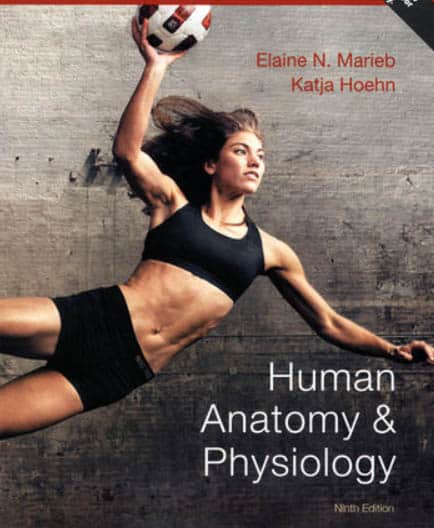The primary dentition consists of _____ teeth.
20
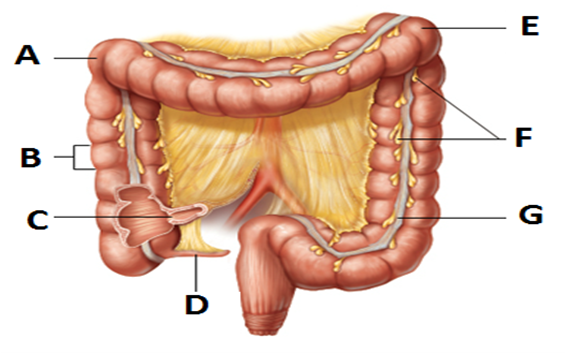
Gross Anatomy of large intestine
a. right colic (hepatic) flexure
b. Haustrum
c. Ileocecal valve
d. Appendix
e. Left colic (splenic) flexure
f. Epiploic appendages
g. Tenia coli
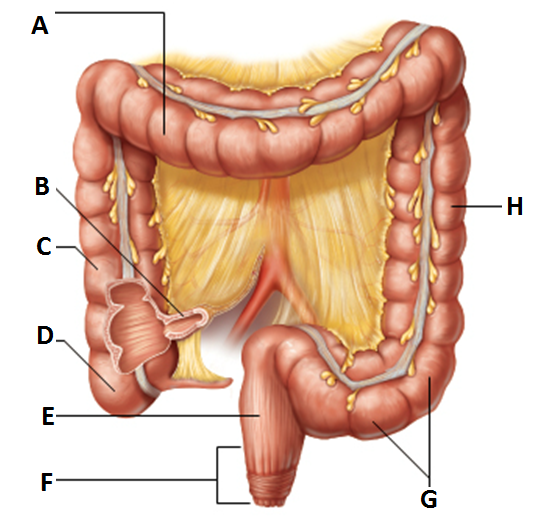
Gross Anatomy of large intestine
a. Transverse colon
b. Ileum
c. Ascending colon
d. Cecum
e. Rectum
f. Anal canal
g. Sigmoid colon
h. Descending colon
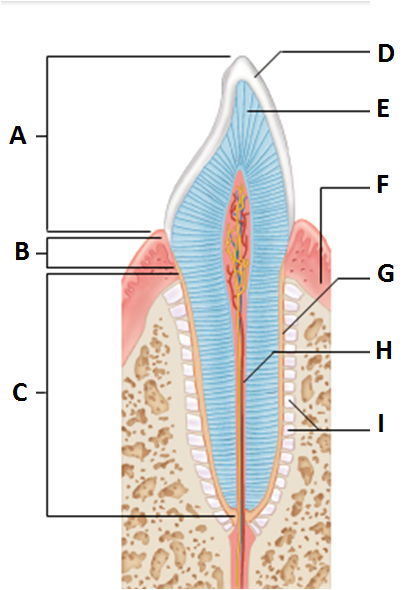
Anatomy of a tooth
a. Crown
b. Neck
c. Root
d. Enamel
e. Dentin
f. Gingiva
g. Cement
h. Root canal
i. Periodontal ligament
Absorbed lipids are transported from intestinal epithelial cells to the lymphatic system in what form?
a. in the form of fatty acids and glycerol
b. in the form of glycerol
c. in the form of micelles
d. in the form of chylomicrons
d. in the form of chylomicrons
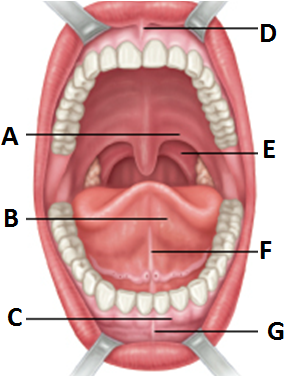
Anterior view of mouth
a. Palatoglossal arch
b. Tongue
c. Gingivae
d. Superior labial frenulum
e. Palatopharyngeal arch
f. Lingual frenulum
g. Inferior labial frenulum
The primary function of the large intestine is:
defecation
Which digestive process normally occurs only in the mouth?
a. digestion
b. propulsion
c. absorption
d. ingestion
d. ingestion
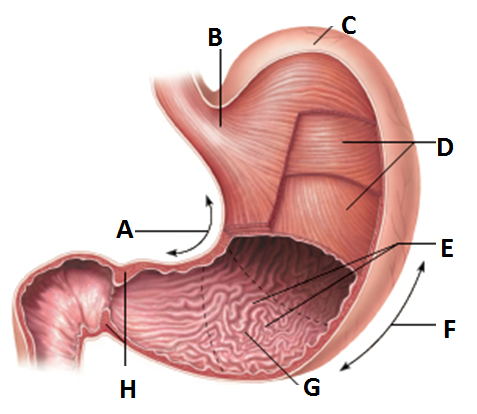
Anatomy of the stomach
a. Lesser curvature
b. Cardia
c. Fundus
d. Body
e. Rugae
f. Greater curvature
g. Pyloric antrum
h. Pyloric sphincter
Proteins are digested into:
Amino acids
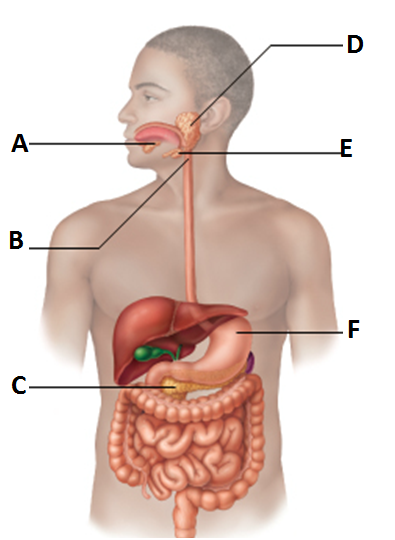
Alimentary canal & *accessory organs
a. Sublingual gland
b. Pharynx
c. Pancreas*
d. Parotid gland
e. Submandibular gland
f. Stomach
Saliva does not:
a. moisten food.
b. clean the mouth.
c. dissolve food chemicals so that they can be tasted.
d. aid in the chemical digestion of proteins.
d. aid in the chemical digestion of proteins.
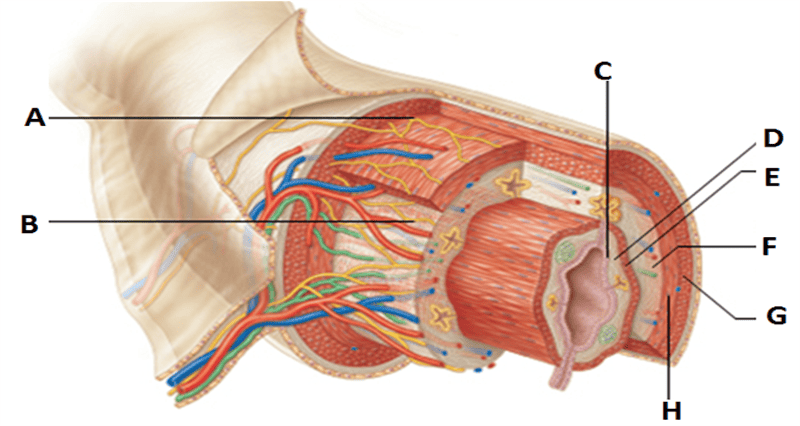
Alimentary canal-basic structure
a. Myenteric nerve plexus
b. Submucosal nerve plexus
c. Epithelium
d. Lamina propia
e. Muscularis mucosae
f. SUBMUCOSA
g. Longitudinal muscle
h. Circular muscle
**4 basic layers: mucosa, submucosa, muscularis externa, serosa
pci
...
Which part of the digestive system is the major location for absorption of the end products of digestion?
a. liver
b. large intestine
c. stomach
d. small intestine
d. small intestine
How are fats absorbed into the blood?
a. in the form of fatty acids and glycerol
b. in the form of micelles
c. in the form of glycerol
d. in the form of chylomicrons
d. in the form of chylomicrons
Which organ of the digestive tract is the body's major digestive organ?
small intestines
Which of the following are mismatched?
a. lipase: fat digestion
b. amylase: carbohydrate digestion
c. nuclease: DNA and RNA digestion
d. protease: lipid digestion
d. protease: lipid digestion
Which enzymes are responsible for the final chemical breakdown of carbohydrates, amino acids, and nucleic acids?
a. proteases
b. amylases
c. brush border enzymes
d. pancreatic enzymes
c. brush border enzymes
______ can result if food passes too slowly through the large intestine.
a. Irritable bowel syndrome
b. Colitis
c. Constipation
d. Diarrhea
c. Constipation
The _______ circulation includes all of the arteries that serve the digestive organs.
a. cardiac
b. hepatic portal
c. splanchnic
d. peritoneal
c. splanchnic
The liver is able to regenerate even after 50% of its original mass is lost. T/F
True
Pic layers of stomach wall
...
PIC Alimentary canal 2
...
A function of the large intestine is to:
a. make intrinsic factor.
b. absorb nutrients.
c. absorb water.
d. produce vitamins
c. absorb water.
Which part of the digestive system is the major location for absorption of the end products of digestion?
a. liver
b. large intestine
c. small intestine
d. stomach
c. small intestine
What is the function of the bacterial flora that inhabit the large intestine?
a. Bacterial flora facilitate nutrient absorption.
b. Bacterial flora synthesize B-complex vitamins and some of the vitamin K needed by the liver.
c. Bacterial flora release a bicarbonate-rich juice to help neutralize chyme from the stomach.
d. Bacterial flora emulsify fats.
b. Bacterial flora synthesize B-complex vitamins and some of the vitamin K needed by the liver.
In the ________ of gastric secretion, chyme is moved into the duodenum.
a. gastric phase
b. intestinal phase
c. reflux phase
d. cephalic phase
b. intestinal phase
The innermost tissue layer of the alimentary canal is the __________.
a. serosa
b. submucosa
c. muscularis
d. mucosa
d. mucosa
PIC Gastric pits and gastric glands
...
PIC Mesenteries of the abdom. digestive organs
...
Bacteria that reside in the large intestine make vitamin K. T/F
T
The major means of propelling food through the digestive tract is ___________.
a. segmentation
b. peristalsis
c. churning
d. swallowing
b. peristalsis
**Peristalsis is the primary means by which food is propelled through the digestive tract. Peristalsis consists of alternate waves of contraction and relaxation of muscles in the organ walls.
Bile is produced by the:
a. gallbladder.
b. pancreas.
c. liver.
d. stomach.
c. liver.
Which vitamins are made by the bacteria in the large intestine?
B complex and K
PIC The 4 layers of the alimentary canal
...
The _______ is the serous membrane that lines the body wall.
a. omenta
b. parietal peritoneum
c. visceral peritoneum
d. mesentery
b. parietal peritoneum
Which of the following is not a structural modification of the small intestine to increase surface area?
a. Microvilli
b. Circular folds
c. Rugae
d. Villi
c. Rugae
Which of the following processes occurs only in the large intestine?
a. propulsion
b. absorption
c. mechanical digestion
d. defecation
d. defecation
The major means of propelling food through the digestive tract is __________.
peristalsis
Proteins are digested into ______.
a. glycerol
b. monosaccharides
c. nucleotides
d. amino acids
d. Amino acids
Blood drained from the stomach is more alkaline (basic) than blood that serves the stomach. T/F
True!
The_________ is the last segment of the small intestine.
a. duodenum
b. colon
c. jejunum
d. ileum
d. ileum
What role of the stomach is essential to life?
a. production of VIP
b. production of hydrochloric acid
c. production of intrinsic factor
d. production of chyme
c. production of intrinsic factor
Which of the following is a water-soluble vitamin?
a. Vitamin E
b. Vitamin D
c. Vitamin A
d. Vitamin C
d. Vita C
What is the major digestive function of the pancreas?
a. production of bicarbonate ions
b. production of insulin
c. production of glucagon
d. production of digestive enzymes
d. production of digestive enzymes
Which of the following is not a characteristic of the stomach?
a. The stomach releases enzymes to digest carbohydrates.
b. The stomach mucosa is folded into rugae.
c. The stomach produces a double-layered coat of alkaline mucus.
d. The stomach has three layers of muscle in the muscularis tunic.
a. The stomach releases enzymes to digest carbohydrates.
Which histological layer of the digestive tract is composed primarily of epithelial tissue?
a. muscularis externa
b. serosa
c. mucosa
d. submucosa
c. mucosa
Which of the following is considered to be an accessory organ of the digestive system?
a. Stomach
b. Mouth
c. Gallbladder
d. Esophagus
c. Gallbladder
Enzymatic breakdown of which of the following compounds doesn’t begin until it reaches the stomach?
a. proteins
b. carbohydrates
c. lipids
a. proteins
Which of the following enzymes is important for breaking down protein?
a. pepsin
b. lipase
c. amylase
a. pepsin
**pepsin breaks down proteins in the stomach
Which of the following enzymes is important for the digestion of fat?
a. pancreatic amylase
b. trypsin
c. pancreatic lipase
d. pepsin
c. pancreatic lipase
**pancreatic lipase is important for the digestion of fats. It is secreted by the pancreas and works in the small intestine.
In the small intestine, which of the following enzymes breaks down maltose?
a. lactase
b. glucoamylase
c. sucrase
d. maltase
e. dextrinase
b. glucoamylase
**the enzyme maltase breaks down the bonds between the two glucose molecules of the disaccharide maltose.
The breakdown products of which of the following are absorbed into lacteals?
a. proteins
b. fats
c. carbohydrates
b. fats
**chylomicrons are absorbed into lacteals because they are too large to pass through the basement membrane of a capillary and into the blood.
The pancreas secretes:
a. procarboxypeptidase.
b. secretin.
c. bile.
d. cholecystokinin (CCK).
a. procarboxypeptidase.
The nervous system does not regulate digestive activity. t/f
false
The _______ guards the entry of food into the stomach.
a. cardiac sphincter
b. pyloric sphincter
c. diaphragm
d. regulatory sphincter
a. cardiac sphincter
